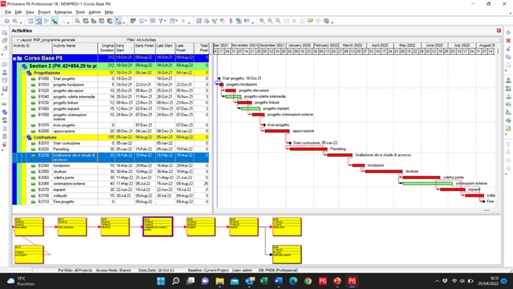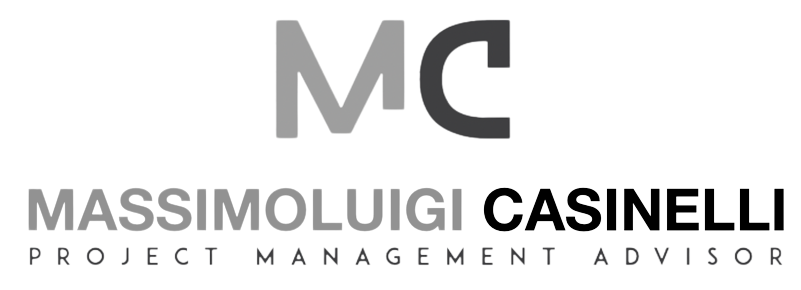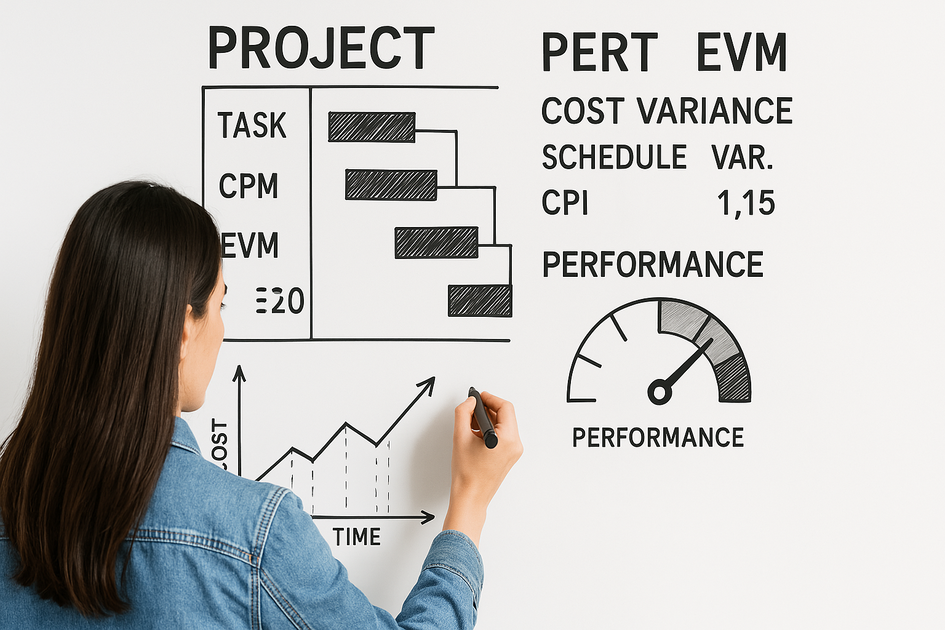Views: 141
In the current panorama of Project Management, The ability to manage complex projects with precision and control is essential to ensure long -term success. Advanced techniques such as the Critical Path Method (CPM) , ovvero il metodo del percorso critico, and theEarned Value Management (EVM) They are powerful tools in the hands of expert project manager, Since they allow you to plan and monitor activities in order to maximize efficiency and minimize risks. These are essential techniques to obtain Project checks effective that support the government of the project.
In this article, We will explore how these advanced methodologies can contribute to the success of the projects, making the project manager and his team more prepared to face daily challenges. Through practical examples and cases of study, we will see how the CPM and theEVM can be applied in real situations to improve the management of complex projects.
Project planning
- Project planning
- Focus on times and costs
- Planning and Schooling techniques
- Reticular programming techniques: CPM e PERT
- Modern software solutions of Risk Analysis Schedule (Rashra)
- Earned Value Management (EVM): The integrated control of the times, Costs and performance of the project
- A case of study
- Conclusion: Successful projects with advanced techniques
Project planning is a complex process that includes:
- the definition of the purpose of work (scope),
- The project program (time) To program the activities necessary for the realization of the project in compliance with the contractual deadlines,
- il Project budget (costs) which establishes the economic and financial objectives to be respected.

In complex projects, The project plan (project plan) It also provides specific levels for risk management, Quality, Contractual changes (change) and other key aspects. These processes must be managed in an integrated way to guarantee Project checks (project controls) effective.
In big projects such as the construction of a metropolitan line or a real estate complex, il Technical specifications of the contract provides for the drafting of Detailed project plans, to be developed in the phase of project planning and approve with the client.
👉 Here comes the competence of the Project Manager: must know the processes of Project Management e Control, To ensure effective management and compliance with objectives.
Ma What are the essential skills?
- Any project, even the smallest, must respect times and costs To be successful.
- One account is manage a project from 20.000 euro in three months, another is manage a project from 100 millions of euros in 30 months.
- To become a successful project manager, need field experience, but also A solid methodological and cultural base.
Focus on times and costs
We will explore three key methodologies for project management:
- PERT (Program Evaluation and Review Technique);
- CPM (Critical Path Method);
- EVM (Earned Value Management).
We will see how these techniques can improve the management of complex projects, through practical examples and cases of study.
If you are already an expert and want to deepen the relationship between CPM and EVM, I recommend our study: 👉 “Earned Value e Critical Path: How to get a perfect synergy“
Planning and Schooling techniques
Among the first modern techniques developed in project management we find:
- Diagramma in Gantt (1910), developed by Eng. Henry Laurence Gantt;
- Critical Path Method (CPM) (1957);
- Program Evaluation and Review Technique (PERT) (1958).
📌 Rososity Su Henry Gantt: He was a mechanical engineer, But it also dealt with optimization and management. His diagram, developed over a century ago, It is still a reference tool in project management.
🔹 However, Gantt's diagram has limitations: it is useful only for projects relatively small (up to about 50 activity).
Per More complex projects, with hundreds or thousands of activities, The reticular programming techniques (CPM e PERT).

Reticular programming techniques: CPM e PERT
There are two fundamental planning and scheduling techniques for complex projects:
- PERT (Program Evaluation and Review Technique).
- CPM (Critical Path Method).
Both represent essential tools to manage projects characterized by:
- Thousands of activities to be coordinated.
- Hundreds of stakeholders involved.
- Technical constraints, constructive and logistics to be respected.
In these contexts, It is not enough to assign start and end dates to the activities. It is necessary to integrate planning with further key elements, including:
- Technical-constructive interactions between activities (executive logic).
- The availability of resources and the management of workloads.
- The sequence between the design phases (From design to purchases, up to testing).
All these aspects translate into logical relationships among the activities that, suitably modeled, give rise to a logical lattice. This graphically represents the operating flow of the project (fig. 2).
So that a program is really feasible, It must be consistent, respect the constraints and take into account the real availability of resources, First of all the workforce.
If in simple projects this analysis can be carried out manually or with basic tools such as Excel, In complex projects (es. 5.000 activity) professional tools are needed for:
- Manage interactions.
- Develop realistic plans.
- Constantly update the program based on advancement.
In these cases, The application of the CPM supported by specialized software it becomes indispensable.
🔹 Today, Pert and CPM are the basis of the main project management software, come Spring P6 e Microsoft Project.
Origins and development of Pert and CPM techniques
These techniques were developed and adopted in the 1950s by government bodies and leading consultancy firm in the sector:
· Il CPM It was developed in 1957 and DuPont e Remington Rand To optimize times in industrial production.
· Il PERT It was introduced in 1958 from the US Navy for the management of the program Polaris.
· Other key institutions in the development of these techniques were the Usa Defense Department, RAND Corporation e Booz Allen Hamilton.
Critical Path Method (CPM): control of time in complex projects
This technique is among the best known and used to plan and control complex projects.
📌 What is it for?
- Identification of the critical path: → allows you to focus on the activities that directly influence the duration of the project.
- Continuous monitoring of progress: → immediately detects any delays and their causes, allowing timely interventions before they affect the entire project
- Resource optimization: → helps to manage and allocate resources more efficiently, focusing on critical activities
📌 Practical example:
A construction company is creating a residential complex. Tramite CPM, the undivided manager is foundations as a critical activity. If the finding of the materials for the foundations underwent a delay, This would influence the entire chronoprogram of the project.
This is a simple example, But in complex projects, The identification of critical activities is indispensable for building realistic and upgradable plans.
Since the situation evolves continuously, it is fundamental dynamically monitor the project and promptly detect any changes to the critical path.
✅ Ultimately,
The CPM is particularly effective in dynamic contexts. Thanks to this technique, The project manager can:
- Temporarily increase resources on critical activities.
- Reprogram those non -critical ones to reduce the impact of any delays.
✅ Ultimately, iThe CPM proves to be precious in these contexts.
Thanks to this methodology, The project manager can take immediate decisions, come:
✔ Increase the supply of resources to avoid slowdowns.
✔ Reprogram less critical activities To reduce the impact of any delays.
📊 Visualization: CPM + Gantt
The following figure shows a program developed with Spring P6, combining:
- il Diagramma in Gantt, Even today a very useful tool, especially when it derives from a structured lattice;
- il logical lattice cpm.

Il Program Evaluation and Review Technique (PERT): time control in situations of uncertainty
The Program Evaluation and Review Technique (PERT) It is a methodology developed to manage projects in which the duration of the activities cannot be defined precisely.
📌 When using?
👉 It is typically applied in development projects, where there are few or no historical data on which to base the duration of the activities of the activities. Furthermore, in these projects the uncertainties are particularly high.
📌 What is the difference between CPM and Pert?
- CPM → used when The duration of the activities are known with certainty.
- PERT → more suitable for projects with high uncertainty, in which they are used probabilistic estimates
📌 How it works?
The Pert calculates the duration of the activities in a probabilistic way; It also considers three scenarios for each activity:
- Optimistic time (TO) → the minimum possible duration.
- Probable time (TP) → the most realistic duration.
- Pessimistic time (TPe) → The maximum time, In case of problems.
Practical example of Pert calculation
The Pert method uses the Formula of the expected duration, Based on beta distribution:

Dove:
- to = Optimistic time (minimum),
- tm = more likely time,
- tp = pessimistic time (massimo),
- the = EXPECTED TIME.
📌 Numerical example of CPM and Pert application
Suppose we have a project with the following activities, for each of which three duration values have been estimated:

Calculated the duration waiting the for each activity, This value can be used for the calculation of the total duration of the project. We must develop the logical lattice of activities and identify the critical course (Critical Path).
The logical network is represented by this figure:

After analyzing the new logical lattice and used the values the (expected) calculated with the Pert formula, il critical course resulting is:
🔹 Critical course: A → B → C → G.
🔹 Total duration of the project (based on the critical path with Pert): 19,0 even if advised in advance of the possibility of such damage.
The total duration of the project must be understood as “minimum duration” necessary to complete the project.
Modern software solutions of Risk Analysis Schedule (Rashra)
Today, Thanks to the QSRA tools (Quantitative Schedule Risk Analysis), It is possible overcome the dualism between CPM and Pert.
📌 What do they allow you to do?
- Integrate Uncertainty intervals in the duration of the activities.
- Consideration to variability and risk more accurately.
- Calibrate specific probability ranges To obtain more realistic forecasts.
Ultimately, these tools allow a more sophisticated risk analysis, Going beyond the limits of traditional scheduling models.
Earned Value Management (EVM): The integrated control of the times, Costs and performance of the project
In the years following the development of CPM and Pert methodologies, Attention moved to organizational and process aspects, leading to the development of more sophisticated methodologies, come l’Earned Value.
The great potential of the AVM
L’Earned Value Management (EVM) It is an advanced methodology of project control which allows you to get a Integrated vision of the progress of the project, By combining cost measurements, Time and progress of work to offer an overall and accurate picture of the performance.
It is a methodology that allows the Project Manager to constantly monitor the costs incurred Compared to those provided for in budget, The works carried out with respect to the planned ones and to analyze the deviations in economic and temporal terms, while evaluating the performances obtained on costs and times.
Ultimately, is a system that allows project checks and sophisticated monitoring, Still Almost completely unknown in Italy.
Origins and development of the EURED VALUE MANAGEMENT (EVM)
L’Earned Value Management (EVM) was born in the early 1960s in the context of progetto Minuteman (1962), with the aim of developing a Integrated time-time control system (Integrated time-cost progress monitoring system).
✔ 1967 → Il Usa Defense Department (DOD) you develop i C/SCSC (Cost/Schedule Control System Criteria), and Integrated-time planning and control system, adopted by all the contractors involved in the DOD projects.
✔ 1971-1972 → the first are published Operational instructions for the implementation of the AVM, including:
🔹 “DOD INSTRUCTION 7000.2”.
🔹 “DOD/C/SCSC Implementation Guide”.
✅ This phase marks a historical moment for project management, since for the first time a project control system is introduced (project controls) structured, capable of recognizing interdependence between times, Costs and technical performances.
- 1991 → the C/SCCs evolve in the EVMS (Earned Value Management Systems), adopted in 1998 as an Ansi standard 748.
- 1996 → Il PMI (Project Management Institute) includes the concept of Earned Value nel PMBOK, officially recognizing it as a project management tool.
- 1998 → Il Usa Defense Department (DOD) adopt it Standard ANSI EVMS 748-98, formalizing the EVM as a control system in government and industrial projects.
- 2002 → L’APM (Association for Project Management) And the UK Ministry of Defense adopt the Enedned Value, expanding its use internationally.
- 2018 → ISO 21508:2018 → L’Earned Value Managemenhttps://www.casinelli.net/congruenza-tra-metriche-earned-value-e-critical-path/t diventa uno standard internazionale, recognized as fundamental methodology for the management of projects and programs.
Metric evm
The complete explanation of the EVM methodology beyond the purpose of this article. You can find more information in this 👉 “Earned Value e Critical Path: How to get a perfect synergy“.
In summary, l’Earned Value Management (EVM) It is based on three basic parameters, from which the performance key indicators derive:
- Planned Value (PV) → Work value planned up to a specific date.
- Earned Value (EV) → value of the work actually done on the same date.
- Actual Cost (AC) → effective cost incurred for the work done.
From these three parameters the main indicators are obtained to evaluate the trend of the project:
📌 Variation of costs and times
- Cost Variance (Cv = ev – AC) → If negative, indica un sovraccosto.
- Schedule Variance (SV = Ev – PV) → If negative, indicates a delay.
📌 Performance indices
- CPI → measures efficiency in the use of the budget.
- SPI → evaluates adherence to planned timing.
✅ These metrics allow you to anticipate future critical issues and to plan effective corrective actions. In summary:
- Accurate forecast of future performances → CPI and SPI allow to anticipate deviations and estimate the effectiveness of the plan.
- Integration between times, Costs and performances → Unlike techniques focused on a single aspect, The EVM offers an integrated and structured vision.
- Timely corrective decisions → Report any budget or calendar deviations in advance, allowing immediate interventions.
The following graph summarizes The main quantities associated with the metrica earned value:

Example of EVM in action
Suppose that, to a certain date, the values are:
- PV (Planned Value) = 100k€,
- EV (Earned Value) = 90k€,
- AC (Actual Cost) = 110k€.
📌 Let's calculate EVM indices:
Cost Variance (CV) = EV – And → 90K – 110K = -20k € → overload of € 20,000.
Schedule Variance (SV) = EV – PV → 90k – 100K = -10k € → delay of € 10,000 compared to planning.
Cost Performance Index (CPI) = EV / And → 90K / 110k = 0,82 → Every euro spent produced only 0.82 € of value.
Schedule Performance Index (SPI) = EV / PV → 90k / 100k = 0,9 → The project is proceeding to 90% of the expected speed.
✅ Synthesis:
These data allow the project manager to evaluate the trend of the project in real time and to adopt targeted corrective strategies.
Integrated approach for guaranteed success
While EVM e CPM are tools powerful even individually, their combined use offer Optimal results in the project control , supporting the management in the decision -making process.
- The CPM provides a clear picture of the deadlines and critical activities.
- The EVM allows you to keep costs under control and evaluate whether resources are used effectively.
- Together, offer a global vision of the project, reducing uncertainties and improving management efficiency.
When used Together with the CPM technique, the methodology EVM allows you to control any project, even the most complex, and keep it on the established route.
A case of study
This article that I published on the prosecutor World Magazine describes a real case of application of the EVM methodology. (Casinelli, M. (2020). Integrated Project Control System based on EVM methodology: a
case history for Quadrilatero programme, Italy; PM World Journal, Vol. IX, Issue IX, September.)
Qui There is a presentation held at the Order of Engineers of Latina.
Beyond the metrics: EVM as an organizational revolution
The adoption of’Earned Value Management System (EVMS) ANSI 748 It is not limited to introducing a project performance measurement system: It represents a organizational transformation which impacts deeply on processes, roles and decision -making structures.
📌 Because EVMS is a revolution?
Exceeds the logic of simple costs and times, providing an integrated system that binds performance, strategic resources and objectives.
Impatta on the organizational structure, requiring an active involvement of all corporate functions (PMO, finance, procurement, operations).
Introduces standardized processes, improving the consistency of information and the ability to make decisions based on concrete data.
📌 The Evms ANSI 748 as a corporate governance tool
- Planning and control processes are structured, making them more effective and transparent.
- They favor communication between stakeholders, ensuring that all organizational levels have access to coherent and reliable data.
- Enable predictive management → instead of detecting rear problems, EVMS allows you to foresee delays and deviations, favoring timely corrective actions.
- ✅ What does it mean for a company?
- Companies that implement EVMS ANSI 748 they no longer limit themselves to monitoring the ex post project costs, but they integrate the management of planning, execution and control in a single system, making the project management a strategic business process.
📌 Conclusion
EVMS is not just a standard: It is an integrated system for planning, measure and control the progress of the projects. Adopting it means strengthening the decision -making process and concretely improving management.
If you want a more strategic vision on the integration between control of times and project performance, I advise you to read this article too: 👉 “Earned Value e Critical Path: How to get a perfect synergy”
Conclusion: Successful projects with advanced techniques
You really want to improve the management of your projects? Techniques such as the CPM and theEVM help to control times, Costs and performances, avoiding delays and waste.
In an increasingly competitive market, Mastering these methodologies is essential to obtain concrete results and improve your career.
🎯 Vuoi padroneggiare le metodologie CPM ed EVM all’interno di un percorso completo e strutturato?
SCOPRI IL PROGRAMMA E I VANTAGGI DEL NOSTRO CORSO AVANZATO DI PROJECT MANAGEMENT E CONTROL:
🎯 Desideri un corso specifico sulle metodologie di gestione dei tempi e controllo avanzamento?
🎯 You prefer an operational focus on the ARNED Value Management, With practical examples and exercises?





